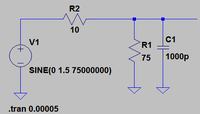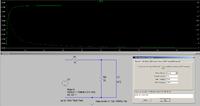itayd100
Junior Member level 3
Hello,
I design the attached circuit:
75 MHz Sine wave that connected to R and C in parallel

The output, the amplitude of the sine wave, is changing according to the C, more capacitance smaller amplitude of the sine wave.
When I tried that in the lab I got 2 results:
1. When I connected the signal generator as an oscillator I got the same results - higher C lower amplitude (of the sine wave in the output)
2. When I connected it to oscillator (https://www.farnell.com/datasheets/75480.pdf) I'm getting different result: the output is a sine wave, but if I make C higher the amplitude becoming lower until the sine wave (in the output) is "flipping" (kind of changing phase) and, if I keeping the C higher, the sine wave in the output getting higher
What are the differences between the two?
How can I make the oscillator work like the wave generator in this case?
I design the attached circuit:
75 MHz Sine wave that connected to R and C in parallel

The output, the amplitude of the sine wave, is changing according to the C, more capacitance smaller amplitude of the sine wave.
When I tried that in the lab I got 2 results:
1. When I connected the signal generator as an oscillator I got the same results - higher C lower amplitude (of the sine wave in the output)
2. When I connected it to oscillator (https://www.farnell.com/datasheets/75480.pdf) I'm getting different result: the output is a sine wave, but if I make C higher the amplitude becoming lower until the sine wave (in the output) is "flipping" (kind of changing phase) and, if I keeping the C higher, the sine wave in the output getting higher
What are the differences between the two?
How can I make the oscillator work like the wave generator in this case?
